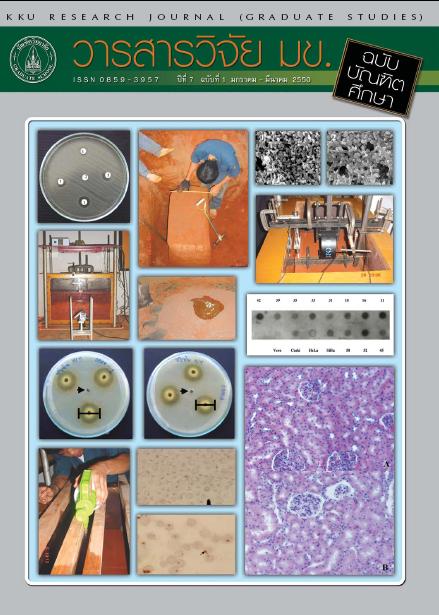Recyclisation of Sugar Acetylene via Dicobalthexacarbonyl Complexes(การปิดวงแหวนซ้ำของซูการ์อะเซทิลีน โดยผ่านสารประกอบเชิงซ้อนของไดโคบอลต์เฮกซะคาร์บอนิล)
Keywords:
Dicobalthexacarbonyl complexes(สารประกอบเชิงซ้อนไดโคบอลต์เฮซะคาร์บอนิล), Recyclisation(การปิดวงแหวนซ้ำ), Reductive amination(ปฏิกิริยารีดักทีฟเอมิเนชัน), C-glycosidation(ปฏิกิริยาซี-ไกลโคซิเดชัน).Abstract
การสังเคราะห์สารประกอบซูการ์อะเซทิลีนเริ่มจากการทำปฏิกิริยา silylation ของสารประกอบ 1 จะได้สารประกอบ 2 นำมาทำปฏิกิริยา C-glycosidation กับ ซูการ์ 3 เกิดเป็นสารประกอบอัลกอฮอล์ 4 จากนั้นทำการเปลี่ยน อัลกอฮอล์ 4 ไปเป็นสารประกอบเชิงซ้อนของไดโคบอลต์เฮกซะคาร์บอนิล 7 โดยผ่านปฏิกิริยา swern oxidation, reductive amination และ complexation ตามลำดับ งานวิจัยนี้ได้ทำปฏิกิริยาปิดวงแหวนซ้ำของซูการ์อะเซทิลีน โดยผ่านสารประกอบเชิงซ้อนของไดโคบอลต์เฮกซะคาร์บอนิล ซึ่งช่วยเสถียรคาร์โบแคทไอออนในตำแน่ง แอลฟา-คาร์บอนของพันธะสาม จากการทดลองพบผลิตภัณฑ์ที่เกิดการ epimerized ที่ตำแหน่ง anomeric carbon เมื่อใช้ trimethylsilyl trifluoromethane sulfonate เป็นกรดลิวอิส
The synthesis of compound 2 was started from silylation of compound 1. C-Glycosidation of compound 2 with D-glucal 3 gave alcohol derivative 4. Transformation of alcohol 4 to the required dicobalthexacarbonyl complexes 7 was carried out by swern oxidation, reductive amination and complexation. This research was concentrated on recyclisation of sugar acetylene via dicobalthexacarbonyl complexes, which has been used to help stabilize carbocationic charge generated at the ?-carbon to the alkyne moiety. The epimerization at anomeric carbon was obserbed when trimethylsilyl trifluoromethane sulfonate was used as Lewis acid.



